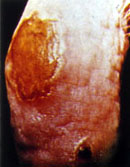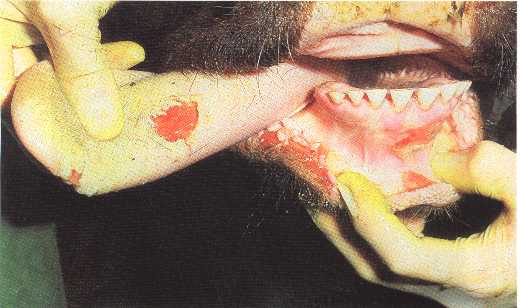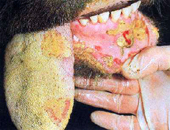|
Anthrax
- Anthrax is an acute, infectious febrile disease of virtually
all animals and man. It is caused by Bacillus anthracis.
- In India, it is well known as the cause of sudden death of cattle,
sheep and goats.
Symptoms
- The disease may occur in a peracute, acute or sub-acute form.
In the first, the animal dies suddenly, rarely showing any symptoms.
- In acute and sub-acute forms, there may be high rise in body temperature
and signs of intense pain.
Treatment and control
- Due to the acute nature of the disease resulting in sudden death,
treatment is usually not possible in animals even though anthrax
bacilli are clines. Treatment is of use in cases showing sub-acute
form of the disease.
 Top
Top
Black-quarter (Black-leg)
- This disease is widespread amongst cattle in certain parts of
India, particularly in Karnataka, Tamil Nadu, Andhra Pradesh and
Maharashtra. Sporadic cases occur in the northern and eastern states
of the country.
- The disease is common in areas with moderate rainfall and where
dry-crop cultivation is common.
- Young animals in the prime of condition and six months to three
years old are affected more than others. Buffaloes usually suffer
from a milder form of the disease. Outbreaks generally occur with
the onset of rains. True black-quarter is caused by Clostridium
chauvoei.
- It affects mostly start and sturdy animals. Fever with redness of
eye. Hot painful swelling in the affected leg. Crepitating sound
on pressing the affected part of muscle. Death may occur in severe
cases in 1 or 2 days
Symptoms
- The disease usually occurs in an acute form, affected animals
dying within 24 to 48 hours of the onset of symptoms.
- There is high fever with a hot, tense, painful swelling usually
in one of the quarters, more often a hind-quarter, although such
swelling may also occur in other before death, the swelling becomes
cold and painless and crepitates on pressure due to the presence
of gas in it.
Prevention and control
- To prevent the spread of infection and contamination of the
soil with spores of the causal organisms, carcases of animals dead
of black-quarter should be either buried deep and covered over with
lime or should be cremated.
- Administration of penicillin in repeated doses may be effective
if injected before muscle damage has been caused.
- Use of black-quarter vaccine protects animals against the disease
for about a year. Animals should be vaccinated with this about three
to one month before the onset of rains.
 Top
Top
Contagious bovine
abortion
- This disease of cattle and buffaloes, usually termed brucellosis,
is caused by Brucella abortus, a small gram-negative coccobacillus,
also known as Bang's bacillus.
- The disease occurs on most breeding farms in western countries.
It is also fairly widely prevalent in India.
Symptoms
- The disease affects animals of all ages and of both sexes.
- In the initial stages it shows no symptoms and hardly any evidence
of fever. As the infection progresses, the organisms become localized
at sites where they are able to persist, the most usual of these
sites in the female being the uterus, the udder and the supramammary
lymph nodes, and in the male the genital glands.
Prevention and control
- Introduced into a fresh herd, the disease may spread rapidly.
- It is, therefore, necessary that before purchasing animals for a
disease-free herd they are carefully examined for evidence of the
infection.
 Top
Top
Bovine mastitis
- This disease is characterized by the inflammation of the udder,
resulting in changes in the udder tissue and its secretion.
- Infectious mastitis results from infection with one or more of the
many organisms associated with cattle in all countries where dairy
industry is well developed, and the disease is of great economic
importance to the milk producer.
- The disease is also widely prevalent in milch animals in India.
- Clinically, the disease may be recognized as acute, sub-acute or
chronic, and these forms may depend on the type of the causal organism
concerned. It may be accompanied by systemic disturbance, with a
rise in body temperature of the affected animal and other febrile
symptoms, but usually it occurs in the form of a localized involvement
of the udder, with a progressive damage to the udder tissue.
- The milk is affected both in quality and in quantity, and as a result
of permanent impairment of the function of one or more quarters
milk production may cease altogether. Both cows and she-buffaloes
suffer from the disease.
Treatment
- Success depends on the nature of the aetiological agent involved,
the severity of the disease and the extent of fibrosis.
- Complete recovery with freedom from bacterial infection can be obtained
in cases of recent infection and in those where fibrosis has taken
place only to a small extent.
- Such drugs as acriflavine, gramicidin and tyrothricin have now ceased
to be in use, and have given place to the more effective drugs,
such as sulphonamides, penicillin and streptomycin.
 Top
Top
Cow pox
- The infection, although mostly occurring in cows, sometimes
also occurs in buffaloes.
- Under natural conditions the infection takes place through inoculation
by the cutaneous route and readily spreads from one animal to another
through the agency of milkers.
- The occurrence of the disease is not often reported since it is
localized only to the teats and udder and occasionally to the hairless
parts of the body.
Buffalo-pox
- Pox occurs in buffaloes, but in a considerably milder form than
in cows.
 Top
Top
Foot-and-mouth disease
- The food-and-mouth disease is a highly communicable disease
affecting cloven-footed animals. It is characterized by fever, formation
of vesicles and blisters in the mouth, udder, teats and on the skin
between the toes and above the hoofs.
- Animals recovered from the disease present a characteristically
rough coat and deformation of the hoof.
- In India, the disease is widespread and assumes a position of importance
in livestock industry.
- The disease spreads by direct contact or indirectly through infected
water, manure, hay and pastures.
- It is also conveyed by cattle attendants. It is known to spread
through recovered animals, field rats, porcupines and birds.
- Foot-and-mouth disease occurs in a relatively milk form in India
and is seldom fatal. It occurs practically all the year round.
Symptoms
- Fever with 104-1050 F
- Profuse salivation ropes of stringy saliva hangs from mouth
- Vesicles appear in mouth and in the inter digital space
- Lameness observed
- Cross bred cattle are highly susceptible to it
Diagnosis
- Quick spread and the occurrence of lesions in the mouth and
feet of affected animals are characteristic symptoms.
- It presents some similarity to rinderpest, from which it can be
readily differentiated by the absence of diarrhaea and by the presence
of the foot lesions.
- It can be cured by severe antibiotic therapy and topical application
of ointments
Treatment
- The external application of antiseptics contributes to the healing
of the ulcers and wards off attacks by flies.
- A common and inexpensive dressing for the lesions in the feet is
a mixture of coal-tar and copper sulphate in the proportion of 5:1.
Control and prevention
- Heavy milch animals and exotic breeds of cattle bred for milk
should be protected regularly.
- It is advisable to carry out two vaccinations at an interval of
six months followed by an annual vaccination programme.
- Isolation and segregation of sick animals. It should be informed
immediately to the veterinary doctor
- Disinfection of animal sheds with bleaching powder or phenol
- Attendants and equipments for sick animals should be ideally separate
- The equipments should be thoroughly sanitized
- Proper disposal of left over feed by the animal
- Proper disposal of carcasses
- Control of flies
 Top
Top
Hemorrhagic septicemia
- This acute septicaemic disease of cattle and buffaloes is widely
prevalent in India. It occurs generally in low-lying areas periodically
inundated by rainwater and in areas where irrigation facilities
have developed.
- The causal organism, Pasteurella multocida, is a small gram-negative
cocco-bacillus, commonly called bipolar organism on account of the
intensity with which is stains at the poles.
- Redness of eye and lancination along with fever. Severe dyspnoea.
Hot painful swelling at head, jowl region or brisket region. In
severe cases sudden death may occur due to high fever and severe
dyspnoea
Symptoms
- The disease generally runs an acute course. Cattle and buffaloes
often develop a highly septicaemic condition and die within the
course of about 24 hours of infection.
- Affected animals show a high rise in body temperature.
- The lesions comprise haemorrhagic spots in the lymph nodes, on the
serous membranes and in other organs, including the inner lining
of the heart; spleen is normal in size.
- The entire gut is highly inflamed and intensely red with bloody
contents.
Treatment and prevention
- Early cases of the disease are amenable to treatment with sulphonamides,
notably sulphadimidine coupled with antibiotics, such as penicillin,
but on account of the short course of the disease and its termination
in sudden death, animals are seldom available in good time for treatment.
- Vaccination with the improved type of adjuvant vaccine, carried
out about a month before the onset of rains, will protect animals
against the attack of the disease for about one year. In endemic
areas such vaccination should be carried out every year.
 Top
Top
Leptospirosis
- Leptospirosis occurs in animals and man in almost all parts
of the world.
- Serological evidence indicates the prevalence of leptospires among
domesticated animals in different parts of the country.
- The damage done to animal industry results from the death of animals
in the acute stage of illness, stillbirth, abortion, stunning, decrease
in weight (loss of meat), reduced milk production and unthriftness.
Causes and pathogenesis
- The causative organisms of leptospirosis belong to the genus
Leptospira.
Symptoms
- In cattle it is an acute, often fatal, disease characterized
by haemorrhage, haemoglobinurai and icterus.
- Non-fatal infections are often characterized by fever, anaemia,
abortions, sterility, decreased lactation and mastitis.
Diagnosis
- The principal methods used for the diagnosis of leptospirosis
are direct microscopical examination of tissue preparations and
body fluids, bacteriological culture, animal inoculation and serological
tests.
Treatment
- In cattle treatment with antibiotics may result in considerable
diminution of even temporary cessation of urinary excretion of leptospires.
 Top
Top
Rinder pest
- Rinderpest is the most destructive of the virus diseases of
cloven-footed animals, such as cattle, buffaloes, sheep, goats,
pigs and wild ruminants. Its control was a major issue till recently
all over the world.
- Organised efforts over half a century have brought about a total
eradication of the disease in the Western Hemisphere.
- The disease still persists in the Asian countries.
- The virus is found notable in the saliva, discharge from eyes and
nostrils, and in the urine and faeces.
- It is present in the circulating blood during the febrile stage
and is later concentrated in different organs, especially in the
spleen, lymph nodes and liver. Outside the animal body, the virus
is rapidly destroyed by direct sunlight and disinfectants. Cold
preserves the virus.
- The virus is usually spread by contaminated feed and water.
- Rise in temperature upto 104 – 107 0 F. Lacrimation and redness
of eye.
- Foul odour from mouth. Discrete necrotic foci develop in the buccal
mucosa, inside lip, and on the tongue. Bloody mucoid diarrhoea is
noticed
Treatment
- Symptomatic treatment with penicillin, streptomycin, sulphadimidine
and intestinal antiseptics has no action on the virus, but may help
in the recovery of less severe cases of rinderpest, as these control
secondary complications caused by bacteria.
 Top
Top
Vibrionic abortion of cattle
- This is a widely prevalent form of abortion in some countries
and the causal organism is Vibrio foetus.
- The disease resembles Br. Abortus infection but is less severe in
form. It is generally transmitted during natural service or artificial
insemination with semen from infected bulls.
Diagnosis
- Diagnosis is made by the examination of uterine exudate and
stomach contents of the foetus.
- The disease is usually self-limiting, infected animals developing
active immunity after one abortion.
- However, hygienic measures should be adopted to prevent spread of
infection.
 Top
Top
Metabolic diseases
Milk fever
- Milk fever, also known as parturient hypocalcaemia and parturient
paresis, is a disease which has assumed considerable importance
with the development of heavy milking cows.
- Decrease in the levels of ionized calcium in tissue fluids is basically
the cause of the disease.
- In all adult cows there is a fall in serum-calcium level with the
onset of lactation at calving.
- The disease usually occurs in 5 to 10 year old cows, and is chiefly
caused by a sudden decrease in blood-calcium level, generally within
48 hours after calving.
Symptoms
- In classical cases, hypocalcaemia is the cause of clinical symptoms.
Hypophosphataemia and variations in the concentration of serum-magnesium
may play some subsidiary role.
- The clinical symptoms develop usually in one to three days after
calving. They are characterized by loss of appetite, constipation
and restlessness, but there is no rise in temperature.
 Top
Top
|





